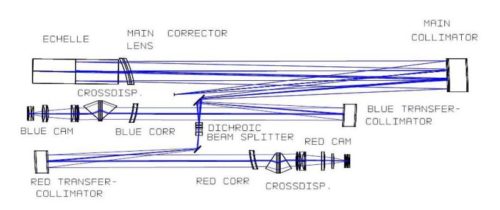Spectrograph
Contents:
PEPSI Spectrograph Optical Design
PEPSI is an asymmetric white-pupil Échelle Spectrograph in Littrow configuration. The spectrograph is located on a 2m x 6m optical table in the telescope pier at level 1, inside a pressure and temperature stabilized/regulated chamber. It can be used during nighttime by the LBT or the VATT, and during daytime by a small solar telescope dubbed SDI.
The 44-m long fibers bring the star and sky light to the spectrograph which is located in a temperature- and pressure-controlled environment in the telescope pier. It receives light from the polarimeters and permanently mounted PFU’s via these fibers, coupled with image slicers. The polarimetric mode provides a resolution of 130,000, while resolutions of 50,000, 130,000 and 250,000 can be obtained with the PFU’s through a choice of different fibers.
Échelle Grating
The Échelle Grating has a groove density of 31.6 gr/mm over a 214mm X 840 (with a central 15mm gap), R4 mosaic of two halves on a joint carrier produced by Richardson Grating Lab. The total wave-front error is 0.142λ at 632.8 nm which limits the maximum spectral resolution to R = 1,250,000. The blaze angle is measured to 75.3±0.4° and the reflectivity on average 67 % (380–680 nm). The off-plane angle of incidence on the échelle is 0.65° (confirmed to 0.70±0.03° after alignment). The CCDs record a total of 92 échelle orders, from the 68-159.
PEPSI Cross Dispersers
In each channel, the spectra are once again collimated and then cross-dispersed by one of three cross-dispersers, each consisting of a VPH grating and 2 prisms. The 6 cross-dispersers cover all 92 orders in the 382-907 nm échelle spectrum. From 15-16 orders fall on the 10K x 10K detector. The spectral ranges of each cross-disperser are given in the Table below for recent (2023) measured ranges for the 100 μm fiber.
Table of Cross-Dispersers
| CD # | spectral range Å | width Å | order range | # orders |
| CDI | 3819-4264 | 445 | 159-145 | 15 |
| CDII | 4219-4787 | 565 | 144-129 | 16 |
| CDIII | 4752-5425 | 673 | 128-114 | 15 |
| CDIV | 5361-6316 | 955 | 113-98 | 16 |
| CDV | 6232-7428 | 1196 | 97-83 | 15 |
| CDVI | 7351-9064 | 1731 | 82-68 | 15 |
The exact spectral range of each cross disperser can vary by a few Åangstroms depending on the fiber used. There is also a slight variation with the telescope used, with a difference of 4Å between SX and DX in the blue and 16 Å between SX and DX in the red. The very edges of the spectrum may not be useful because the respective orders only partially fit on the CCD and appear truncated.
PEPSI Cameras
The two spectrograph cameras are each equipped with a monolithic 10.3k×10.3k Semiconductor Technology Associates (STA) CCD with 9 µm pixels. They have an 7/3 focal ratio with all-refractive surfaces. Their optical designs have been wavelength-optimized.
Blue Camera
The blue camera consists of 9 lenses with a free entrance aperture of 200mm. The camera transmission peaks at 94% at the red cutoff, 82% at ~400nm, and about 70% at 383 nm.
Red Camera
The red camera consists of 10 lenses with a free entrance aperture of 200mm.
PEPSI Image Slicers
The resolution obtained with PEPSI is defined by the combination of fiber (100, 200, or 300) with the corresponding image slicer. Each fiber entering the spectrograph is equipped with its own image slicer. The total of four resolution/observing modes, three for integral light and one for polarimetric light, requires a total of 16 image slicers. The overall efficiency is set by the sampling of the diameter of the entrance beam with n slices. The f-ratio is transformed from the fiber from an f/3 to an f/13.9 to match the collimator entrance with a mirror re-imaging system with an overall efficiency of 93% for all wavelengths.
The image slicer separation sets the spectrum separation per échelle order on the CCD. The number of échelle orders per cross disperser has been fixed to 15 or 16. With a CCD real estate of 10560×10560 pixels also in the cross-dispersion direction, it converts on average to 170 pix per image slicer, i.e. per fiber. An individual image slicer splits this, again on average, into a spectrum height of 57 pix/slice for the 3-slice image slicer (300 μm fiber), 34 pix/slice for the 5-slice image slicer (200 μm fiber), and 24 pix/slice for the 7-slice image slicer (100 μm fiber).
| Fiber | Sky Diameter (“) | # of slices (n) | Slicer Width (μm) | R=λ/Δλ | R Sampl. (pix) |
|---|---|---|---|---|---|
| 100 | 0.74 | 7 | 0.11 | 250,000 | 2.0 |
| 200 | 1.5 | 5 | 0.30 | 130,000 | 4.2 |
| 300 | 2.3 | 3 | 0.77 | 50,000 | 12.1 |
PEPSI Shutters
Each spectrograph arm is quipped with its own “Bonn Shutter” made up of 2 moving blades. Less than 1ms timing accuracy is achieved by very precise motion of both blades, thus 1ms is the minimum exposure time. The exposure-time error is ≤ 300 μs and the exposure non-uniformity is less than 1 ms over the entire field of view.


